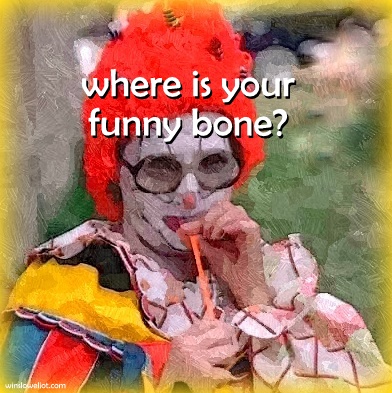
Stillness 9-25: There’s an energy center in our body called the clown chakra or humerus chakra. It’s situated around the dorsal area of our backs, between our heart and throat chakra and spreads out through our humerus bones. It’s also connected to our solar plexus and our throat chakras, giving it, at various times, the colors of celestial blue of balance and harmony and the clear vibrant yellow of joy. Its shape is the lemniscate, the symbol of infinity, and ancient traditions describe this chakra as the wings of enlightened or angelic beings. It connects us to our spirit, our eternal self, and the love that we are. It messages us through light and laughter.
The concept that “laughter is the best medicine” originated (as far as we know) in 1300 when Henri de Mondeville, a surgeon and teacher, taught that humor helped in the healing after an operation. I’ve written before about the physiological and psychological healing effects of laughter: that it lowers blood pressure, epinephrine, and glucose levels, and that it increases glucose tolerance. That it assists in the recovery and prevention of illness, improves our defense against respiratory infections, that it releases endorphins that have both euphoric and calming effects. Even serious Dr. Freud admitted that humor can help to dispel anxiety.
Late one wintry afternoon, driving back to the house after a day of skiing in the Alps, the car hit an icy patch. This was back in 1970, and the road between the town and the slopes was winding and narrow. On our left, steep rocky hills rose up sharply and on the other side was a sheer drop of thousands of feet. At the time I was fifteen years old, seated in the back seat between two friends. The driver, a parent of one of my friends, swore as the car skidded and veered toward the edge of the cliff. Frantically, he turned the wheel around and around, trying to get the car back under control. The car revolved rapidly once, then twice, then three times, each revolution bringing us closer to the edge of the precipice and our doom. In the back seat we clutched each other’s hands in terror. Then somehow the car wheels gripped the road again, swung abruptly away from the outer edge, and landed nose-first into the snowy bank on the opposite side of the road.
For a moment we sat in stunned silence. Then we all broke out laughing. Even the driver laughed! It was the loudest, most happy laughter I’ve ever heard, and sometimes when I’m feeling things are just too dire I remember our laughter as though it were yesterday.
“This world is a comedy to those that think, a tragedy to those that feel,” wrote Horace Walpole in 1769. But words—and thought—hide the mystery of our feelings and laughter and tears express it wholly. Don’t be afraid to laugh. And if you accidently hit your funny bone, and the pain is intense, you might start to cry. That’s okay too.
